Elena Morotti
An incremental algorithm for non-convex AI-enhanced medical image processing
May 13, 2025Abstract:Solving non-convex regularized inverse problems is challenging due to their complex optimization landscapes and multiple local minima. However, these models remain widely studied as they often yield high-quality, task-oriented solutions, particularly in medical imaging, where the goal is to enhance clinically relevant features rather than merely minimizing global error. We propose incDG, a hybrid framework that integrates deep learning with incremental model-based optimization to efficiently approximate the $\ell_0$-optimal solution of imaging inverse problems. Built on the Deep Guess strategy, incDG exploits a deep neural network to generate effective initializations for a non-convex variational solver, which refines the reconstruction through regularized incremental iterations. This design combines the efficiency of Artificial Intelligence (AI) tools with the theoretical guarantees of model-based optimization, ensuring robustness and stability. We validate incDG on TpV-regularized optimization tasks, demonstrating its effectiveness in medical image deblurring and tomographic reconstruction across diverse datasets, including synthetic images, brain CT slices, and chest-abdomen scans. Results show that incDG outperforms both conventional iterative solvers and deep learning-based methods, achieving superior accuracy and stability. Moreover, we confirm that training incDG without ground truth does not significantly degrade performance, making it a practical and powerful tool for solving non-convex inverse problems in imaging and beyond.
Deep Guess acceleration for explainable image reconstruction in sparse-view CT
Dec 02, 2024Abstract:Sparse-view Computed Tomography (CT) is an emerging protocol designed to reduce X-ray dose radiation in medical imaging. Traditional Filtered Back Projection algorithm reconstructions suffer from severe artifacts due to sparse data. In contrast, Model-Based Iterative Reconstruction (MBIR) algorithms, though better at mitigating noise through regularization, are too computationally costly for clinical use. This paper introduces a novel technique, denoted as the Deep Guess acceleration scheme, using a trained neural network both to quicken the regularized MBIR and to enhance the reconstruction accuracy. We integrate state-of-the-art deep learning tools to initialize a clever starting guess for a proximal algorithm solving a non-convex model and thus computing an interpretable solution image in a few iterations. Experimental results on real CT images demonstrate the Deep Guess effectiveness in (very) sparse tomographic protocols, where it overcomes its mere variational counterpart and many data-driven approaches at the state of the art. We also consider a ground truth-free implementation and test the robustness of the proposed framework to noise.
LIP-CAR: contrast agent reduction by a deep learned inverse problem
Jul 15, 2024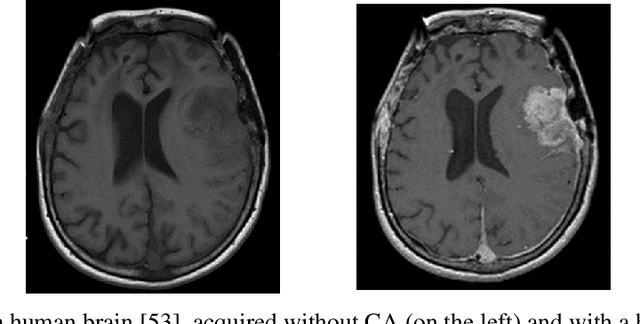
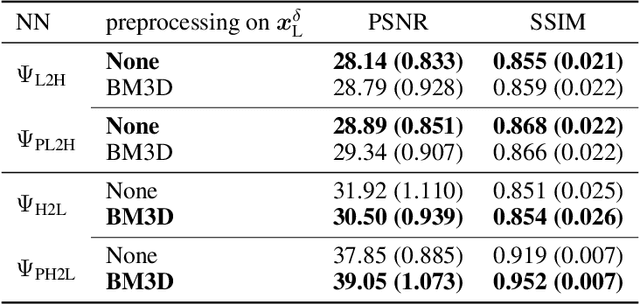
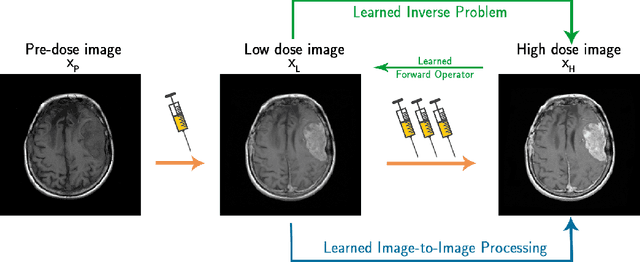

Abstract:The adoption of contrast agents in medical imaging protocols is crucial for accurate and timely diagnosis. While highly effective and characterized by an excellent safety profile, the use of contrast agents has its limitation, including rare risk of allergic reactions, potential environmental impact and economic burdens on patients and healthcare systems. In this work, we address the contrast agent reduction (CAR) problem, which involves reducing the administered dosage of contrast agent while preserving the visual enhancement. The current literature on the CAR task is based on deep learning techniques within a fully image processing framework. These techniques digitally simulate high-dose images from images acquired with a low dose of contrast agent. We investigate the feasibility of a ``learned inverse problem'' (LIP) approach, as opposed to the end-to-end paradigm in the state-of-the-art literature. Specifically, we learn the image-to-image operator that maps high-dose images to their corresponding low-dose counterparts, and we frame the CAR task as an inverse problem. We then solve this problem through a regularized optimization reformulation. Regularization methods are well-established mathematical techniques that offer robustness and explainability. Our approach combines these rigorous techniques with cutting-edge deep learning tools. Numerical experiments performed on pre-clinical medical images confirm the effectiveness of this strategy, showing improved stability and accuracy in the simulated high-dose images.
Space-Variant Total Variation boosted by learning techniques in few-view tomographic imaging
Apr 25, 2024Abstract:This paper focuses on the development of a space-variant regularization model for solving an under-determined linear inverse problem. The case study is a medical image reconstruction from few-view tomographic noisy data. The primary objective of the proposed optimization model is to achieve a good balance between denoising and the preservation of fine details and edges, overcoming the performance of the popular and largely used Total Variation (TV) regularization through the application of appropriate pixel-dependent weights. The proposed strategy leverages the role of gradient approximations for the computation of the space-variant TV weights. For this reason, a convolutional neural network is designed, to approximate both the ground truth image and its gradient using an elastic loss function in its training. Additionally, the paper provides a theoretical analysis of the proposed model, showing the uniqueness of its solution, and illustrates a Chambolle-Pock algorithm tailored to address the specific problem at hand. This comprehensive framework integrates innovative regularization techniques with advanced neural network capabilities, demonstrating promising results in achieving high-quality reconstructions from low-sampled tomographic data.
Deep image prior inpainting of ancient frescoes in the Mediterranean Alpine arc
Jun 25, 2023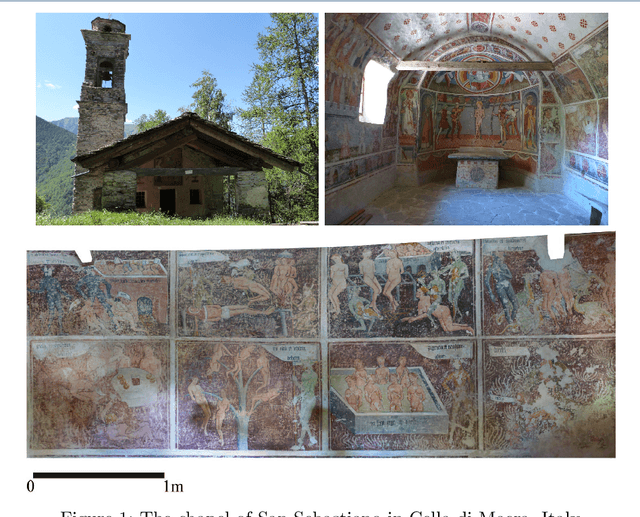
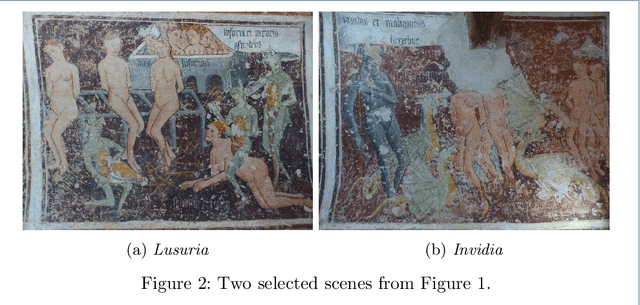
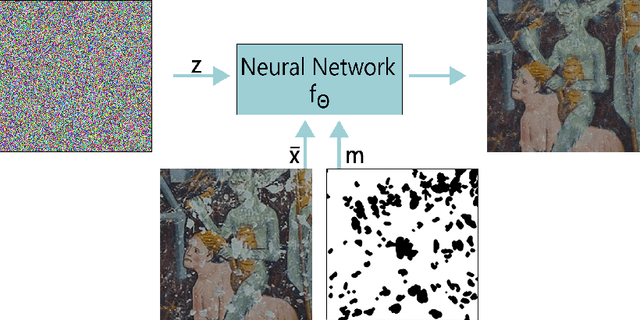
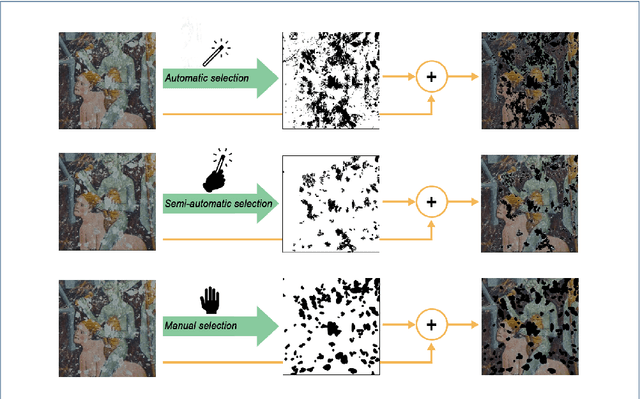
Abstract:The unprecedented success of image reconstruction approaches based on deep neural networks has revolutionised both the processing and the analysis paradigms in several applied disciplines. In the field of digital humanities, the task of digital reconstruction of ancient frescoes is particularly challenging due to the scarce amount of available training data caused by ageing, wear, tear and retouching over time. To overcome these difficulties, we consider the Deep Image Prior (DIP) inpainting approach which computes appropriate reconstructions by relying on the progressive updating of an untrained convolutional neural network so as to match the reliable piece of information in the image at hand while promoting regularisation elsewhere. In comparison with state-of-the-art approaches (based on variational/PDEs and patch-based methods), DIP-based inpainting reduces artefacts and better adapts to contextual/non-local information, thus providing a valuable and effective tool for art historians. As a case study, we apply such approach to reconstruct missing image contents in a dataset of highly damaged digital images of medieval paintings located into several chapels in the Mediterranean Alpine Arc and provide a detailed description on how visible and invisible (e.g., infrared) information can be integrated for identifying and reconstructing damaged image regions.
Ambiguity in solving imaging inverse problems with deep learning based operators
May 31, 2023Abstract:In recent years, large convolutional neural networks have been widely used as tools for image deblurring, because of their ability in restoring images very precisely. It is well known that image deblurring is mathematically modeled as an ill-posed inverse problem and its solution is difficult to approximate when noise affects the data. Really, one limitation of neural networks for deblurring is their sensitivity to noise and other perturbations, which can lead to instability and produce poor reconstructions. In addition, networks do not necessarily take into account the numerical formulation of the underlying imaging problem, when trained end-to-end. In this paper, we propose some strategies to improve stability without losing to much accuracy to deblur images with deep-learning based methods. First, we suggest a very small neural architecture, which reduces the execution time for training, satisfying a green AI need, and does not extremely amplify noise in the computed image. Second, we introduce a unified framework where a pre-processing step balances the lack of stability of the following, neural network-based, step. Two different pre-processors are presented: the former implements a strong parameter-free denoiser, and the latter is a variational model-based regularized formulation of the latent imaging problem. This framework is also formally characterized by mathematical analysis. Numerical experiments are performed to verify the accuracy and stability of the proposed approaches for image deblurring when unknown or not-quantified noise is present; the results confirm that they improve the network stability with respect to noise. In particular, the model-based framework represents the most reliable trade-off between visual precision and robustness.
To be or not to be stable, that is the question: understanding neural networks for inverse problems
Nov 24, 2022Abstract:The solution of linear inverse problems arising, for example, in signal and image processing is a challenging problem, since the ill-conditioning amplifies the noise on the data. Recently introduced deep-learning based algorithms overwhelm the more traditional model-based approaches but they typically suffer from instability with respect to data perturbation. In this paper, we theoretically analyse the trade-off between neural networks stability and accuracy in the solution of linear inverse problems. Moreover, we propose different supervised and unsupervised solutions, to increase network stability by maintaining good accuracy, by inheriting, in the network training, regularization from a model-based iterative scheme. Extensive numerical experiments on image deblurring confirm the theoretical results and the effectiveness of the proposed networks in solving inverse problems with stability with respect to noise.
Plug-and-Play external and internal priors for image restoration
Feb 15, 2021



Abstract:Image restoration problems were traditionally formulated as the minimization of variational models, including data-fidelity and regularization terms, performed by optimization methods with well-established convergence properties. Recently, Plug-and-Play (PnP) methods for image restoration have obtained very good results and popularity by introducing, in iterative proximal algorithms, any off-the-shelf denoiser as priors. Deep Convolutional Neural Network (CNN) denoisers specify external priors (related to an outer training set) which well reflect image statistics; however they fail when dealing with unseen noise variance and image patterns in the given image. Conversely, the so-called internal denoisers induce internal priorsta ilored on the observed data, by forcing specific features on the desired image. We propose a new PnP scheme, based on the Half-Quadratic Splitting proximal algorithm, combining external and internal priors. Moreover, differently from other existing PnP methods, we propose a deep denoiser acting on the image gradient domain. Finally, we prove that a fixed point convergence is guaranteed for the proposed scheme under suitable conditions. In the experimental part, we use CNN denoisers and the Total Variation functional specifying external and internal priors, respectively. We prove the effectiveness of the proposed method in restoring blurred noisy images, both in simulated and real medical settings.
 Add to Chrome
Add to Chrome Add to Firefox
Add to Firefox Add to Edge
Add to Edge